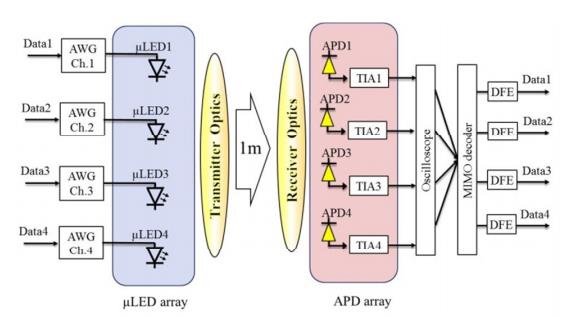Energy Efficiency Optimization for MIMO Visible Light Communication Systems
Objective
Focus on maximizing the energy efficiency (EE) of MIMO VLC systems, where the non-negativeness of the transmit signal, the optical and electrical power constraints, and the data rate and bit error rate (BER) requirements are taken into account.
Abstract
In this project, we focus on maximizing the energy efficiency (EE) of MIMO VLC systems. As, Multiple-input multiple-output (MIMO) visible light communication (VLC) systems can support high data rates for indoor communications. Where the non-negativeness of the transmit signal, the optical and electrical power constraints, and the data rate and bit error rate (BER) requirements are taken into account.
The formulated problem is a difficult nonlinear fractional program. We exploit the Dinkelbach’s algorithm and Lagrangian analysis to obtain a semi closed form solution. The performance advantage of the proposed design is verified by simulation results.
Keywords: Energy efficiency (EE), Fractional Programming, Multiple-Input Multiple Output (MIMO), Visible Light Communication (VLC)
NOTE: Without the concern of our team, please don't submit to the college. This Abstract varies based on student requirements.
Block Diagram

Specifications
Software: Matlab 2018a or above
Hardware:
Operating Systems:
- Windows 10
- Windows 7 Service Pack 1
- Windows Server 2019
- Windows Server 2016
Processors:
Minimum: Any Intel or AMD x86-64 processor
Recommended: Any Intel or AMD x86-64 processor with four logical cores and AVX2 instruction set support
Disk:
Minimum: 2.9 GB of HDD space for MATLAB only, 5-8 GB for a typical installation
Recommended: An SSD is recommended A full installation of all Math Works products may take up to 29 GB of disk space
RAM:
Minimum: 4 GB
Recommended: 8 GB
Learning Outcomes
· Introduction to Matlab
· What is EISPACK & LINPACK
· How to start with MATLAB
· About Matlab language
· Matlab coding skills
· About tools & libraries
· Application Program Interface in Matlab
· About Matlab desktop
· How to use Matlab editor to create M-Files
· Features of Matlab
· Basics on Matlab
· What is Communication?
· About Communication
· Introduction to Communication
· How Communication Works?
· Importing the System Design, Characterization and Visualization
· Analyzing of BER tool
· Analyzing of Error Rate Test Console
· Generation of WSN
· WSN network creation
· Nodes Communication
· Clustering
· Routing
· Convolutional
· Equalization and Synchronization etc.,
· How to extend our work to another real time applications
· Project development Skills
o Problem analyzing skills
o Problem solving skills
o Creativity and imaginary skills
o Programming skills
o Deployment
o Testing skills
o Debugging skills
o Project presentation skills
o Thesis writing skills


 Paper Publishing
Paper Publishing
